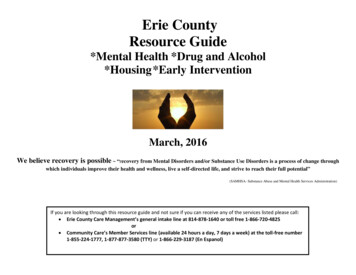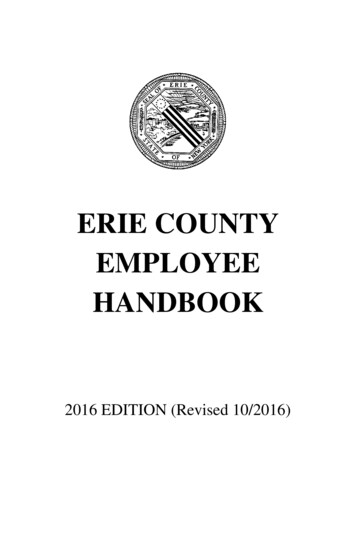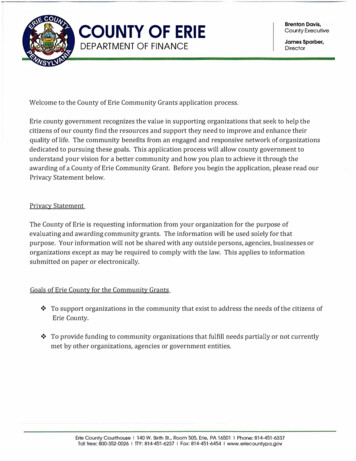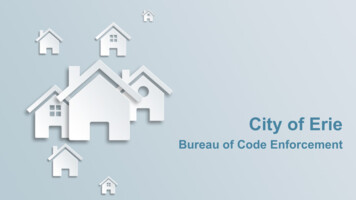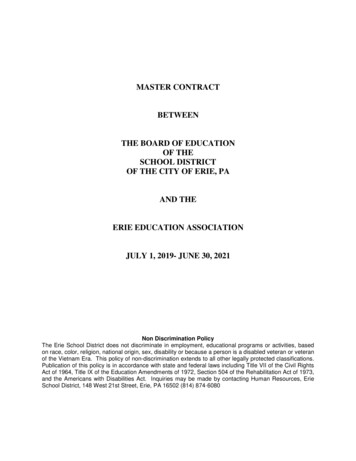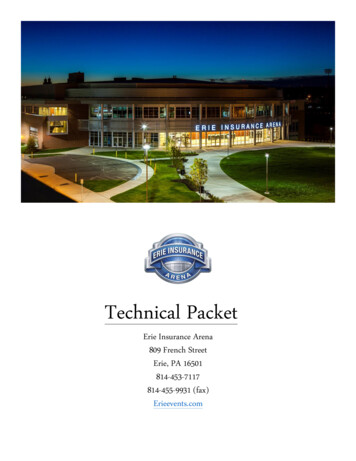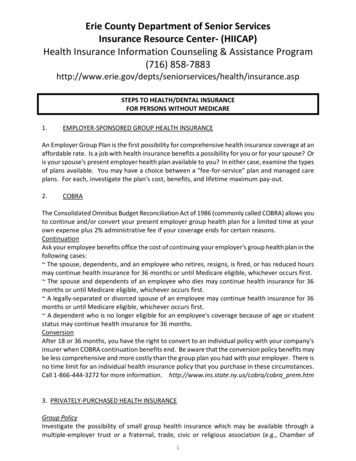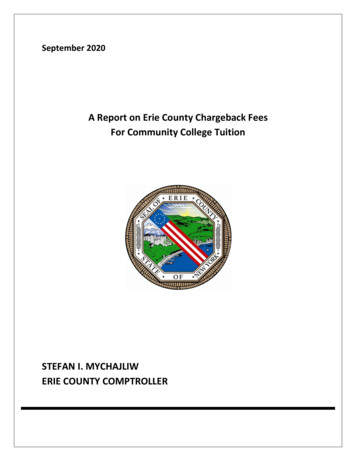
Transcription
September 2020A Report on Erie County Chargeback FeesFor Community College TuitionSTEFAN I. MYCHAJLIWERIE COUNTY COMPTROLLER
HON. STEFAN I. MYCHAJLIWERIE COUNTY COMPTROLLER’S OFFICEDIVISION OF AUDIT & CONTROL95 FRANKLIN STREETBUFFALO, NEW YORK 14202September 9, 2020Erie County Legislature92 Franklin Street 4th FloorBuffalo, New York 14202Dear Honorable Members:The Erie County Comptroller’s Office has completed a report on the cost of chargeback fees to Erie Countytaxpayers over the past five years. For the purpose of this report, the office looked at the overall expenseof chargebacks, and an itemized breakdown of money due to community colleges throughout New YorkState.Our objectives were to: Ascertain the cost of community college chargebacks in each of the past five yearsAscertain the total amount of Erie County tax dollars spent in other communitiesReview potential causes of Erie County students seeking educational opportunities outside of ErieCountyTo accomplish these objectives, we reviewed SAP to see all payments associated with chargebacks, for2015 through 2019.As a result of our examination, we have provided information that may be helpful in a discussion regardinghow best to proceed with handing community college funding both within and outside of Erie County.2
Table of ContentsBackground . 4Five Year Cost of Chargeback Fees to Erie County. 52019 Breakdown of Chargeback Fees . 5SUNY Erie Impact . 7Conclusions . 8Recommendation. 83
BackgroundCommunity colleges are a vital part of the secondary education framework. They grant all peopleof our community the opportunity for continued education and training to allow them personal andprofessional success. Whether the students are recent high school graduates, non-traditional,second career individuals, continuing education, students from other schools supplementing theirstudies or people just looking for a new challenge, these institutions provide a valuable service.The many courses and programs offered allow students to graduate with myriad associate’sdegrees, certificates, skilled trades, as well as acting as a stepping stone for students who wishto pursue a four-year bachelor’s degree at another institution.While community colleges are important and they are accounted for in the county budget, thereis a large financial burden which is widely unknown to taxpayers: chargeback fees. These feesare incurred by Erie County every time a county resident chooses to attend a community collegeoutside Erie County. Erie County must pay a fee to the other New York State county for the rightof the Erie County resident to attend classes.This means that while Erie County taxes are funding Erie Community College (SUNY Erie) toallow county residents to receive an education, they are taxed again when a resident decidesthey would rather attend, for example, Niagara County Community College (NCCC). Erie Countytaxpayers have already paid their taxes to help fund SUNY Erie, but now additional money isneeded to pay a chargeback to NCCC.Students attending community colleges outside of Erie County, like all college students, arerequired to take general studies courses which are also offered at SUNY Erie, and as such ErieCounty taxpayers are being charged twice. The student who chooses NCCC could have attendedSUNY Erie to take those courses without the additional chargeback fee to Erie County. Theirdecision to attend NCCC added an additional tax burden to Erie County taxpayers.A large part of the problem seems to be attracting and retaining students to attend SUNY ERIEover other community colleges, and thus reducing or eliminating the need for Erie County to paychargebacks to other counties.4
Five Year Cost of Chargeback Fees to Erie CountyWhile compiling information, the Comptroller’s Office pulled the total cost of chargeback fees toErie County in 2015 through 2019:2015 6,864,202.012016 6,928,238.39Erie County Chargeback Fees20172018 6,928,178.04 7,124,894.842019 7,381,087.39Starting in 2015, the cost to Erie County was 6,864,202.01, and it has grown to 7,381,087.39in five years. On average, the amount in chargeback cost to Erie County has increased byapproximately 2% per year, with it being 1% from ’15 to ’16, 0% from ’16 to ’17, and then 3% eachyear from ’17 to ’18 and ’18 to ’19. This seems to be a steady trend of growth, and should beconcerning as these are community college costs which are in addition to the Erie CountyLegislature’s approved budgeted amount for SUNY Erie operations.During the five-year look back period for this report, Erie County has spent 35,226,600.67 onchargebacks to other communities.2019 Breakdown of Chargeback FeesIn 2019, Erie County paid 27 community colleges chargeback fees. Leading the list are NCCCwith 4,606,312.26 covering 28,602 course hours; Genesee Community College (GCC) with 1,036,028.08 covering 6,474 course hours; and Fashion Institute of Technology (FIT) with 964,802.08 covering 1,744.5 course hours.The table below is a comprehensive list of all schools and the number of course hours Erie Countywas charged:2019 RPT School Chargeback by utchessFashion InstituteFinger LakesFulton-MontgomeryGeneseeHerkimer5Sum of CR 015.006,474.00481.00Sum of Total 3,120.00 48,843.33 52,349.68 2,222.33 9,619.85 5,851.99 964,802.08 117,514.40 1,740.00 1,036,028.08 66,932.29
Hudson ValleyJamestownJeffersonManhattanMohawk ValleyMonroeNiagaraNorth mpkinsUlsterWestchesterGrand ,662.00 23,451.84 153,091.23 4,088.67 4,302.00 16,309.67 192,006.51 4,606,312.26 7,384.67 22,452.17 4,226.01 1,890.00 3,700.67 3,410.00 19,680.68 9,128.98 628.00 7,381,087.39The Comptroller’s Office also looked at which municipalities in Erie County the students attendingcommunity colleges resided in. We have broken down the cost by the municipality that studentsreside in and number of course hours. Amherst had the most with 1,216,536.86 in fees and7,152 course hours; the City of Buffalo is second with 1,022,184.40 in fees and 5,841.50 coursehours; and third is Cheektowaga with 869,872.22 in fees and 5,475 course hours.It should be noted that both the Town of Amherst and the City of Buffalo, which are larger inpopulation, do house SUNY Erie campuses, North Campus and City Campus, respectfully. TheTown of Orchard Park, which houses South Campus, had 135,255.56 in fees and 538.5 coursehours. In total, the three municipalities housing the three SUNY Erie campuses cost Erie County 2,374,076.82 in fees for 13,532 course hours for students who choose to travel outside ErieCounty rather than attend colleges located nearby.Breakdown of the 2019 cost by municipality:2019 RPT School Chargeback by MunicipalityRow aga6Sum of CR 5.00Sum of Total 217,402.97 1,216,536.86 119,677.62 10,863.20 19,937.35 1,022,184.40 869,872.22
ClarenceColdenCollinsConcordEdenElmaEvansGrand teadNorth CollinsOrchard ParkSardiniaTonawanda CityTonawanda TownWalesWest SenecaGrand 00 216,390.79 21,468.01 68,403.19 68,829.59 32,725.75 58,346.34 97,269.89 640,560.34 426,560.07 34,312.40 52,751.24 263,135.33 17,884.00 219,042.20 12,467.33 135,355.56 40,792.90 367,264.48 943,367.46 29,914.37 157,771.53 7,381,087.39SUNY Erie ImpactOn June 18, 2020 the Comptroller’s office issued a report stating that the student population forSUNY Erie has decreased by 33.5% over the past nine (9) years. State funding for SUNY Eriehas declined by nearly 300,000 during that same span, while the Erie County Legislature hasincreased funding by more than 1,000,000. Tuition over that span increased 49.5%, making theSUNY Erie’s tuition higher than the average community college in New York State.*The Comptroller’s report can be viewed here: https://www2.erie.gov/comptroller/index.php?q ent-and-fiscal-concernsSUNY Erie estimates in 2020-21 it will lose as much as 31 million, over one-third of its overalloperating revenue due to COVID-19 and declining enrollment. To address this, on June 25th, ErieCommunity College’s board of trustees unanimously approved a revised budget, which wasreduced to 83.9 million budget, down 22 million from the original approved operating budget of 105.9 million for the 2020-2021 school year. In this budget the board included another 3%increase in tuition.7
Due to the effects of COVID-19 and an uncertain future with regards to state funding, studentretention, and distance learning in the new environment, SUNY Erie is in the process of arestructuring and reducing its staff, reducing costs through cutting of programs and classesoffered to students.ConclusionsErie County’s chargeback fees for community colleges have grown during the past 5 years at anaverage rate of 2% per year. Concurrently, enrollment has declined and tuition has increased.Erie County taxpayers provide operational and capital support to SUNY Erie, as well as pay aportion of the tuition for Erie County students who attend community college in another county.Increasing student enrollment, particularly among students who seek to attend community collegein other counties, would tend to reduce the per student subsidy expended to SUNY Erie, as wellas reduce the cost of chargebacks to Erie County taxpayers. Of course, this simple and obvioussolution is far easier to state than to implement. Given the inability to increase enrollment andreduce student flight, it may be advisable to pursue other strategies to make community collegeeducation more affordable for Erie County taxpayers.RecommendationWE RECOMMEND that the Board of Directors of SUNY Erie convene a panel of stakeholders,including business leaders, students, taxpayers, and Legislators, to evaluate the services thatSUNY Erie provides and re-envision the services that it will provide in the future.Further, WE RECOMMEND that consideration be given to the appropriate program offerings forthe Western New York community; the most efficient use of physical space and number ofcampuses; the method of teaching (on-campus, online, hybrid, etc.); partnerships with othereducational institutions; the administrative structure of providing these services; and any othersteps that will provide educational resources to students, meeting the needs of the community,while at the same time respecting taxpayers of the community.8
SUNY Erie to take those courses without the additional chargeback fee to Erie County. Their . To address this, on June 25th, Erie Community College's board of trustees unanimously approved a revised budget, which was reduced to 83.9 million budget, down 22 million from the original approved operating budget of
